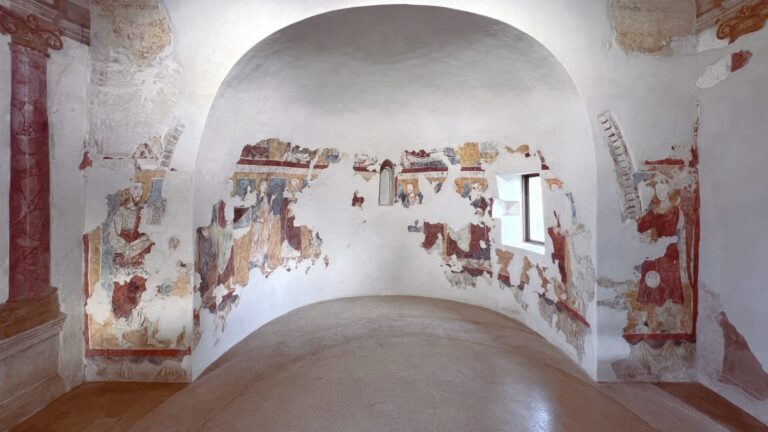ARTISTS’ ROADS
LE VIE DEGLI ARTISTI
watch the videos at the bottom of the page!
GODEGA SANT’URBANO
The Oratory of Sant’Urbano del Campardo. A Window onto Paradise
The Archpriestal Church of San Giovanni Battista in San Fior. Polyptych by Cima da Conegliano. Flanking St. John the Baptist are eight saints. They represent the patrons of the daughter churches of this ancient mother church: shown full-length for parish churches, and half-length for simple chapels. At the top left is Pope Urban I, wearing the papal tiara and holding the processional cross.
It alludes to Sant’Urbano del Campardo.
This small sacred building is recorded as a rural oratory as early as the twelfth century.
Towards the end of the thirteenth century, an anonymous fresco artist painted the apse. With just a few pigments – lime white, ochres, and azurite – he opened a window onto Paradise. This is what the faithful once contemplated as they looked upon the painted cycle that cloaked this liturgical space.
Over time, part of the original conch collapsed. Today, the richness of colour and figures survives only in fragments, and relies in part on our imagination.
Five figures can still be made out, the hems of their robes and their footwear are still visible. Strikingly elegant. At the centre, Christ enthroned – in the so-called Maestà iconography – most likely flanked by the Evangelists, arranged in pairs.
Further below, a scroll bears the names of the twelve Apostles. And here they are, as though on a stage, standing to witness the vision and engaging in animated conversation. Each one holds a book in his hands. It contains the Word that each is called to proclaim, marking the beginning of the first evangelisation. But at this moment, the book is closed. It is not needed. Christ is present. In him, the Word has become flesh.
On the triumphal arch, to the left, John the Baptist points to him.
To the right, the Archangel Michael weighs the souls, crowded into the pans of a scale: a reminder that humankind is free to choose.
This church has a sister. In fact, a twin. A physical resemblance that reflects a partially shared history. It is the Church of San Giorgio Martire in Manzana di Formeniga, in the municipality of Vittorio Veneto. Not on the plain this time, but on a hilltop, in a strategically chosen position overlooking the surrounding countryside, like a sentinel.
Here too, within this ancient church, an anonymous fresco painter was at work, closely related in style to the one at Sant’Urbano. He too was an itinerant artist, a specialist in the so-called pittura presta, a rapid painting technique on whitewash. The wall was coated in lime, and the subject was sketched in such a way that parts of the white underlayer remained visible. Its brightness was used to enhance the colours.
But let us return to the Church of Sant’Urbano del Campardo. Recent restoration work has brought other decorations to light, this time in the nave. They tell of a radical renovation of the interior, carried out around 1681.
Columns and arches in red marble structure a late Baroque architectural illusion. Bright bouquets of flowers, here and there, breathe freshness into the composition and lead the eye to the grand garland on the counter-façade, inside which stands the coat of arms of Patriarch Alvise Sagredo.
The recent restoration of this heritage of beauty is a civilising act for the local community, and at the same time, for all of humanity.
Since 25 May 2014, the feast of Sant’Urbano, this small building has come back to life. Now deconsecrated, it serves as a venue for conferences and concerts.
To inhabit it is to dwell within history.
MORE EXPERIENCES!
I dodici inviati: immagini degli Apostoli:
- Guido Cadorin nella parrocchiale di Moriago
- La pieve di San Pietro di Feletto
- Carlo Donati e Giuseppe Modolo nell’arcipretale di Sernaglia
- L’oratorio di San Giorgio a Manzana, Vittorio Veneto
MULTIMEDIAL MAP: “ARTISTS’ ROADS – LE VIE DEGLI ARTISTI- EN”!

